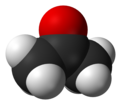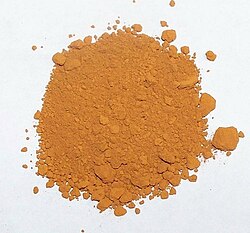In chemistry, a reaction intermediate, or intermediate, is a molecular entity arising within the sequence of a stepwise chemical reaction. It is formed as the reaction product of an elementary step, from the reactants
and/or preceding intermediates, but is consumed in a later step. It
does not appear in the chemical equation for the overall reaction.
For example, consider this hypothetical reaction:
- A + B → C + D
If this overall reaction comprises two elementary steps thus:
- A + B → X
- X → C + D
then X is a reaction intermediate.
The phrase reaction intermediate is often abbreviated to the single word intermediate, and this is IUPAC's preferred form of the term. But this shorter form has other uses. It often refers to reactive intermediates. It is also used more widely for chemicals such as cumene which are traded within the chemical industry but are not generally of value outside it.
IUPAC definition
The IUPAC Gold Book defines an intermediate as a compound that has a lifetime greater than a molecular vibration, is formed (directly or indirectly) from the reactants, and reacts further to give (either directly or indirectly) the products of a chemical reaction. The lifetime condition distinguishes true, chemically distinct intermediates, both from vibrational states and from transition states (which, by definition, have lifetimes close to that of molecular vibration).
The different steps of a multi-step reaction often differ widely in their reaction rates. Where the difference is significant, an intermediate consumed more quickly than another may be described as a relative intermediate. A reactive intermediate is one which due to its short lifetime does not remain in the product mixture. Reactive intermediates are usually high-energy, are unstable and are seldom isolated.
Common reaction intermediates
Carbocations
Cations, often carbocations, serve as intermediates in various types of reactions to synthesize new compounds.
Carbocation intermediates in alkene addition
Carbocations are formed in two major alkene addition reactions. In an HX addition reaction, the pi bond of an alkene acts as a nucleophile and bonds with the proton of an HX molecule, where the X is a halogen atom.
This forms a carbocation intermediate, and the X then bonds to the
positive carbon that is available, as in the following two-step
reaction.
- CH2CH2 + HX → CH3CH+2 + X−
- CH3CH+2 + X− → CH3CH2X
Similarly, in an H2O addition reaction, the pi bond of an alkene acts as a nucleophile and bonds with the proton of an [H3O]+ molecule. This forms a carbocation intermediate (and an H2O atom); the oxygen atom of H2O then bonds with the positive carbon of the intermediate. The oxygen finally deprotonates to form a final alcohol product, as follows.
- CH2CH2 + [H3O]+ → CH3CH+2 + H2O
- CH3CH+2 + H2O → [CH3CH2OH2]+
- [CH3CH3OH2]+ + H2O → CH3CH2OH + [H3O]+
Carbocation intermediates in nucleophilic substitution
Nucleophilic substitution reactions occur when a nucleophilic molecule attacks a positive or partially positive electrophilic center by breaking and creating a new bond. SN1 and SN2 are two different mechanisms for nucleophilic substitution, and SN1 involves a carbocation intermediate. In SN1, a leaving group
is broken off to create a carbocation reaction intermediate. Then, a
nucleophile attacks and forms a new bond with the carbocation
intermediate to form the final, substituted product, as shown in the
reaction of 2-bromo-2-methylpropane to form 2-methyl-2-propanol.
- (CH3)3CBr → (CH3)3C+
- (CH3)3C+ + H2O → (CH3)3COH+2
- (CH3)3COH+2 → (CH3)3COH + H+
In this reaction, (CH3)3C+ is the formed carbocation intermediate to form the alcohol product.
Carbocation intermediates in elimination reactions
β-elimination or elimination reactions
occur through the loss of a substituent leaving group and loss of a
proton to form a pi bond. E1 and E2 are two different mechanisms for
elimination reactions, and E1 involves a carbocation intermediate. In
E1, a leaving group detaches from a carbon to form a carbocation
reaction intermediate. Then, a solvent removes a proton, but the electrons used to form the proton bond form a pi bond, as shown in the pictured reaction on the right.

Carboanions
A carboanion
is an organic molecule where a carbon atom is not electron deficient
but contain an overall negative charge. Carboanions are strong
nucleophiles, which can be used to extend an alkene's carbon backbone in
the synthesis reaction shown below.
- C2H2 with NaNH2 in NH3(l) → CHC−
- CHC− + BrCH2CH3 → CHC−CH2CH3
The alkyne carbanion, CHC−, is a reaction intermediate in this reaction.
Radicals
Radicals
are highly reactive and short-lived, as they have an unpaired electron
which makes them extremely unstable. Radicals often react with hydrogens
attached to carbon molecules, effectively making the carbon a radical
while stabilizing the former radical in a process called propagation.
The formed product, a carbon radical, can react with non-radical
molecule to continue propagation or react with another radical to form a
new stable molecule such as a longer carbon chain or an alkyl halide.
The example below of methane chlorination shows a multi-step reaction involving radicals.
Methane chlorination
Methane chlorination is a chain reaction. If only the products and reactants are analyzed, the result is:
- CH4 + 4 Cl2 → CCl4 + 4 HCl
However, this reaction has 3 intermediate reactants which are formed during a sequence of 4 irreversible second order reactions until we arrive at the final product. This is why it is called a chain reaction. Following only the carbon containing species in series:
- CH4 → CH3Cl → CH2Cl2 → CHCl3 → CCl4
Reactants: CH4 + 4 Cl2
Products: CCl4 + 4 HCl
The other species are reaction intermediates: CH3Cl, CH2Cl2, CHCl3
These are the set of irreversible second-order reactions:
- CH4 + Cl2 → CH3Cl + HCl
- CH3Cl + Cl2 → CH2Cl2 + HCl
- CH2Cl2 + Cl2 → CHCl3 + HCl
- CHCl3 + Cl2 → CCl4 + HCl
These intermediate species' concentrations can be calculated by integrating the system of kinetic equations. The full reaction is a free radical propagation reaction which is filled out in detail below.
Initiation: This reaction can occur by thermolysis (heating) or photolysis (absorption of light) leading to the breakage of a molecular chlorine bond.
- Cl−Cl Cl• + Cl•
When the bond is broken it produces two highly reactive chlorine atoms.
Propagation: This stage has two distinct reaction classes. The first is the stripping of a hydrogen from the carbon species by the chlorine radicals. This occurs because chlorine atoms alone are unstable, and these chlorine atoms react with one the carbon species' hydrogens. The result is the formation of hydrochloric acid and a new radical methyl group.
- CH3−H + Cl• → CH3• + H−Cl
- CH2Cl−H + Cl• → CH2Cl• + H−Cl
- CHCl2−H + Cl• → CHCl2• + H−Cl
- CCl3−H + Cl• → CCl3• + H−Cl
These new radical carbon containing species now react with a second CHCCl2 molecule. This regenerates the chlorine radical and the cycle continues. This reaction occurs because while the radical methyl species are more stable than the radical chlorines, the overall stability of the newly formed chloromethane species more than makes up the energy difference.
- CH3• + Cl−Cl → CH3Cl + Cl•
- CH2Cl• + Cl−Cl → CH2Cl2 + Cl•
- CHCl2• + Cl−Cl → CHCl3 + Cl•
- CCl3• + Cl−Cl → CCl4 + Cl•
During the propagation of the reaction, there are several highly reactive species that will be removed and stabilized at the termination step.
Termination: This kind of reaction takes place when the radical species interact directly. The products of the termination reactions are typically very low yield in comparison to the main products or intermediates as the highly reactive radical species are in relatively low concentration in relation to the rest of the mixture. This kind of reaction produces stable side products, reactants, or intermediates and slows the propagation reaction by lowering the number of radicals available to propagate the chain reaction.
There are many different termination combinations, some examples are:
Union of methyl radicals from a C-C bond leading to ethane (a side product).
- CH3• + CH3• → CH3−CH3
Union of one methyl radical to a Cl radical forming chloromethane (another reaction forming an intermediate).
- CH3• + Cl• → CH3Cl
Union of two Cl radicals to reform chlorine gas (a reaction reforming a reactant).
- Cl• + Cl• → Cl2
Applications
Biological intermediates
Reaction
intermediates serve purposes in a variety of biological settings. An
example of this is demonstrated with the enzyme reaction intermediate of
metallo-β-lactamase, which bacteria can use to acquire resistance to commonly used antibiotics such as penicillin. Metallo-β-lactamase can catalyze β-lactams,
a family of common antibiotics. Spectroscopy techniques have found that
the reaction intermediate of metallo-β-lactamase uses zinc in the
resistance pathway.
Another example of the importance of reaction intermediates is
seen with AAA-ATPase p97, a protein that used in a variety of cellular
metabolic processes. p97 is also linked to degenerative disease and cancer. In a study looking at reaction intermediates of the AAA-ATPase p97 function found an important ADP.Pi nucleotide intermediate is important in the p97 molecular operation.
An additional example of biologically relevant reaction intermediates can be found with the RCL enzymes, which catalyzes glycosidic bonds. When studied using methanolysis, it was found that the reaction required the formation of a reaction intermediate.
























